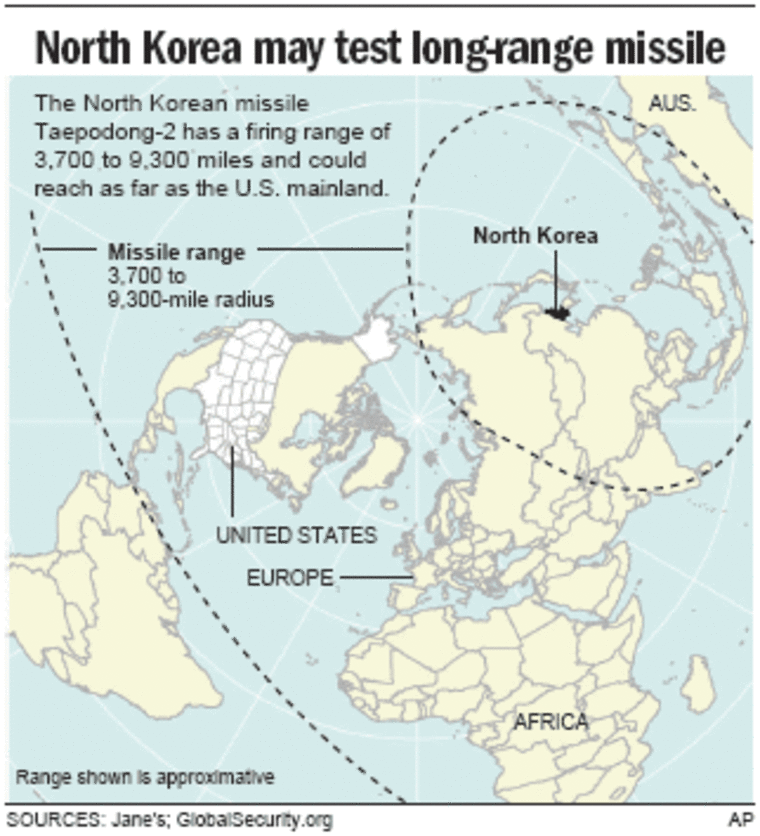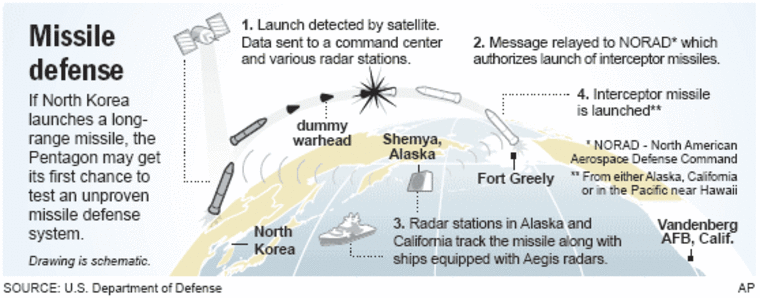The U.S. suggested Thursday it has limited ability to shoot a North Korean missile out of the sky and spurned suggestions of a pre-emptive strike on the ground. Still, it warned the Koreans would pay a cost for a missile launch.
A military official told NBC News Thursday that the missile was not expected to come near the United States or any of its territories. The official said the government is still unsure if North Korea will fire the missile, but noted the earliest the country could launch it would be Sunday because of weather.
The official, who spoke on condition of anonymity, told NBC the government would only attempt to shoot down the missile if it posed a direct threat to U.S. territory. An execution order from the Pentagon lays out a very specific series of guidelines, concerning the missile's trajectory, altitude, speed and flight path before any of the 11 interceptor missiles could be fired, the official said.
Missile defense suffered setbacks
The nation’s missile defense system, which now includes about a dozen interceptor missiles in Alaska and California and on some Navy ships, has suffered multiple test failures since President Bush ordered the Reagan-era program accelerated in early 2001.
Missile defense experts disagree on current U.S. ability to destroy a long-range missile once it is fired. But they seemed in agreement that shooting at it — and missing — would be a huge embarrassment.
A better solution, said Bush’s national security adviser, Stephen Hadley, was for the North Koreans to “give it up and not launch” the missile that the U.S. believes is being fueled and prepared. “We think diplomacy is the right answer and that is what we are pursuing,” he said.

Prepared to use defense system
Tensions persisted over North Korea’s apparent preparations to test-fire a Taepodong-2 missile amid disagreements over U.S. military options for responding. The missile, with a believed range of up to 9,300 miles, is potentially capable of reaching the mainland United States.
Pentagon officials said they were prepared to use the nation’s missile defense system if needed.
Asked under what circumstances it would be used against a North Korean missile, Defense Secretary Donald H. Rumsfeld said Thursday, “The president would make a decision with respect to the nature of the launch, whether it was threatening to the territory of the United States or not, and the likely threat that it would pose.”
Rumsfeld expressed no sense of alarm about the missile situation. “It’s clear: All the intelligence suggests they have been making preparations for a launch of a missile from the area of Taepo Dong for some days now. There’s a lot we know and a lot we don’t know. So we’ll just have to see.”
Missile defense test Thursday successful
Meanwhile, a Navy ship intercepted a medium-range missile warhead above the Earth’s atmosphere off Hawaii in the latest test of the U.S. missile defense program, the military said Thursday.
The military had initially scheduled the test for Wednesday but postponed the drill after a small craft ventured into a zone that had been blocked off for the event.
The USS Shiloh detected a medium-range target after it was launched from the Pacific Missile Range Facility on Kauai, then fired a Standard Missile-3 interceptor.
The interceptor shot down the target warhead after it separated from its rocket booster, more than 100 miles above the Pacific Ocean and 250 miles northwest of Kauai, the Missile Defense Agency said in a statement.
The agency said the test had been scheduled for months and was not prompted by indications that North Korea was planning to test launch a long-range missile.
The modified ‘Star Wars’
The U.S. missile defense program is a downscaled land-and-sea version of a global defense network first proposed by Reagan that was dubbed “Star Wars” by critics. Interceptor missiles — linked to a network of satellites, radar, computers and command centers — are designed to strike and destroy incoming ballistic missiles.
The Pentagon says the system is capable of defending against a limited number of missiles in an emergency — such as a North Korean attack. More than $100 billion has been spent on the program since 1983, including $7.8 billion authorized for the current fiscal year.
A Navy ship late last month successfully shot down a long-range missile in its final seconds of flight. Before this, Interceptor tests have failed at least five out of 12 times.
If launch, official says N. Korea will face cost
In developments Thursday:
- William Perry, a Clinton administration defense secretary, advocated a strike on the missile on its launch pad. “Diplomacy has failed, and we cannot sit by and let this deadly threat mature,” Perry and former assistant defense secretary Ashton B. Carter wrote in Thursday’s Washington Post.
- Vice President Dick Cheney said North Korea’s “missile capabilities are fairly rudimentary” but developments were being closely monitored. In a CNN interview, Cheney rejected Perry’s suggestion of a pre-emptive strike, saying, “The issue is being addressed appropriately.”
- Peter Rodman, assistant secretary of defense for international security affairs, said Pyongyang risks unspecified retaliation in proceeding. “If such a launch takes place, we would seek to impose some cost on North Korea,” Rodman told the House Armed Services Committee.
Loren Thompson, a defense consultant at the Lexington Institute in Arlington, Va., cited “two basic problems” with trying to shoot down a Korean missile in the air. “Our system is barely operational. And the impact on Korean perceptions if we miss could be counterproductive.”
Said Ivo Daalder, a former Clinton national security aide now at the Brookings Institution: “Either it won’t work, in which case you’ve just undermined the rationale for the system. Or if it does work, you have created an even bigger international crisis.”
U.S. downplaying preemptive strike
Hadley brushed aside Perry’s suggestion for a pre-emptive strike. Instead, he said, “We hope it (North Korea) would come back to the table, and we hope it would be a little sobered by the unanimous message that the international community has sent.”
No international talks to persuade North Korea to restrict its nuclear program have been held since last November. The five other nations in the talks — the U.S., China, Russia, Japan and South Korea — have all strongly urged the North not to launch the missile.
Hadley, who briefed reporters in Budapest, Hungary, during a Bush visit, expressed some reservations about the U.S. ability to intercept and destroy such a missile: “It is a research development and testing capability that has some limited operational capability.”
“If the North Koreans fire the missile and the president chooses to launch an interceptor, the administration has an odd set of options,” said Daryl Kimball, executive director of the private Arms Control Association.
“If it hits the missile, will the North Koreans consider that an act of war? And if the interceptor misses the North Korean test missile, it would simply illustrate the fact that we spent tens of billions of dollars for a system that’s not effective — even against one missile from one known launch point.”
